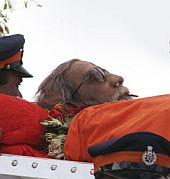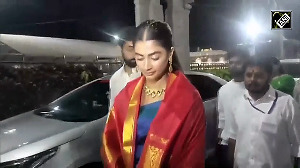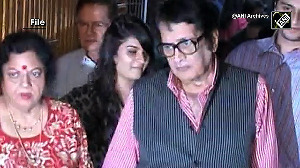
The sea of humanity that turned up on Sunday to bid Bal Thackeray farewell wanted to resurrect the legend that he once was, says Prasanna D Zore
At 6.15 on Sunday evening, Uddhav Bal Thackeray lit his father's funeral pyre at Shivaji Park, an arena where his father had fought many battles all his life.
That moment ended an era named Bal Keshav Thackeray or Balasaheb Thackeray or just Saheb as his legions of followers affectionately hailed him.
That moment may have, perhaps, given birth to another legend: Bal Keshav Thackeray.
But legends just don't happen. Legends are born when a leader captures the collective imagination of the people he wants to lead.
Balasaheb did that without much effort: In life as well as in death.
For Mumbaikars, on November 14, the day began at around 10.30 pm when word spread that Balasaheb Thackeray, who had ailing for a while, was critical. Within no time, scores of television crews gathered outside Matoshree, Thackeray's home in Kala Nagar, the artists' colony in Bandra-East, northwest Mumbai.
A sizable crowd of Shiv Sena supporters beat the media in the race to Matoshree. These cadres had been concerned about their Senapati's deteriorating health for some time. They wasted no time that night to reach Matoshree and make their presence felt.
For the next three days, the media and the Mawalas (as Shiv Sena workers are affectionately described for their love for Balasaheb, a direct comparison to the love of Shivaji's Mawalas for the legendary Maratha general) fought inch-by-inch on the roads outside Matoshree to perpetuate the legend of their beloved leader.
But the real winner in this battle was the man from Matoshree whose diktat once ruled Mumbai's streets. That was the time when he was young and roused the rabble.
That aura began to fade from 1995 when his party, in alliance with the Bharatiya Janata Party, formed the government in Maharashtra, riding an anti-Congress wave two years after the city was scorched in the riots that followed the demolition of the Babri Masjid on December 6, 1992.
Thackeray had then admitted that he had exhorted his followers to adopt violence on Mumbai's streets.
By 1999, the burden of legislative politics had completely taken its toll on the Tiger's legend. The saffron alliance, which had promised the moon to the people, failed miserably to keep its word.
Punishment in the 1999 state election was swift and sharp.
It was downhill for Thackeray in the decade that followed.
His trusted lieutenant Narayan Rane, who was anointed Maharashtra's chief minister after his predecessor Manohar Joshi fell foul with Matoshree, defected to the Congress in 2005.
A year later, his beloved nephew Raj Thackeray split the Sena in 2006 to chart out his own political future.
Both Raj and Rane were not happy with Uddhav's elevation as the party's working president.
The two leaders leaving the party did not dent Thackeray's credibility as much as the fact that the defectors lived to tell their tale.
Remember a former Shiv Sainik named Chhagan Bhujbal and the way he was hounded six years after he had defected to the Congress in 1991? Bal Thackeray was 71 when Bhujbal's house was ransacked in 1997 and still had the muscle to summon his cadres to the streets and avenge the defection.
By 2006, Thackeray had turned 80 and the will to summon his street armies had declined significantly. Though the Sena under Uddhav Thackeray's leadership won the Brihanmumbai Municipal Corporation election in 2012, the party was almost decimated in the 2009 Lok Sabha and legislative assembly elections, when a resurgent Congress and an equally aggressive Maharashtra Navnirman Sena, headed by Raj, weakened its Mumbai citadel.
The legend of Thackeray had begun to wane as Shiv Sainiks took advantage of his failing health and Uddhav's soft-spoken approach as against his father's street-smartness.
The events on the night of November 14 changed all that.
For the next three days, as the Sena chief fought with Yamraj (God of death, so said his well-wishers), his supporters battled the media. As prayers and supporters began pouring in from all corners of the state towards Matoshree, his legend was once again in ascendancy.
Some time post 4 pm on November 17, when his long-time physician Dr Jalil Parkar declared that Balasaheb had breathed his last at 3.30 pm that day, his legend had a global footprint.
Soon, people across Maharashtra -- his supporters and even detractors -- shut shops (even if grudgingly) and refused to light up their houses for Diwali. Taxis and autorickshaws in Mumbai, Pune and Nashik stopped plying.
This immediately reminded one of the Tiger's heyday when just a whimper -- forget his roar -- from him would make Mumbai's lifelines take cover.
Crowds began gathering outside Matoshree in large numbers. They were agitated, excited and aggressive. They were ready for a fight on the streets and almost itching for it.
That Uddhav and senior Sena leaders exhorted them time and again to maintain peace saved the day for the city. But the frenzy had already been unleashed.
This frenzy spilled on to the streets of Mumbai on November 18 when Thackeray's funeral procession that began at 9.04 am from Matoshree reached Shivaji Park by 5 pm.
Hundreds of thousands of Mumbaikars lined up the 7-km stretch between the Sena supremo's home and his karmabhoomi at Shivaji Park. An equal number -- if not more (trying to estimate the crowd's numerical strength is a difficult task) -- poured in to see their general being consigned to the holy flames.
But there was one telling difference between the crowd that once responded to the general's call and were prepared to lay down their lives for him and the crowd that lined up outside Matoshree on Sunday morning and at Shivaji Park in the evening.
The crowd outside Matoshree and Shivaji Park was not the 'rally crowd' or the 'bandh crowd': The one that attends the Shiv Sena's Dussehra rallies or responds to the Sena supremo's bandh calls.
These were ordinary people.
The ones who vote for the Shiv Sena in elections.
The ones who don't hit the streets to enforce bandhs or flex their muscles at rallies.
At other times they would crowd the streets only if they were dragged out by the shakha pramukhs and vibhag pramukhs.
On Sunday, it was spontaneous.
In fact, that has been the case since November 14.
The sea of humanity that turned up on Sunday wanted to resurrect the legend that Bal Thackeray once was. They almost have.
It is now for the Shiv Sena under Uddhav's leadership to keep the embers of his father's funeral pyre burning till 2014. Just like his father fanned and kept alive the communal passions that had engulfed Mumbai in 1992-1993.
Bal Thackeray kept the fire alive in his life and death. It's time for the son to fuel it.
The legend is no more. Long live the legend!








 © 2025
© 2025